Luckily for me, both sides of my family had habits of frugality, which included saving stuff and reusing it or keeping it in case one day it might come in handy. Some folks might call it hoarding, but I value the presence of old handed-down objects, even if no longer used, which are signifiers of a time when people were more in touch with where their food came from.
My small collection of inherited kitchenalia reminds me of how self-sufficient my grandparents’ generation was compared to many urbanites these days who heavily depend on highly processed foods and pre-packaged meals to an extent that my grandparents might have regarded as a form of learned helplessness. In the prevailing Western culture that pursues eternal youth, it can appear that in some respects we have forgotten how to be functioning adults.
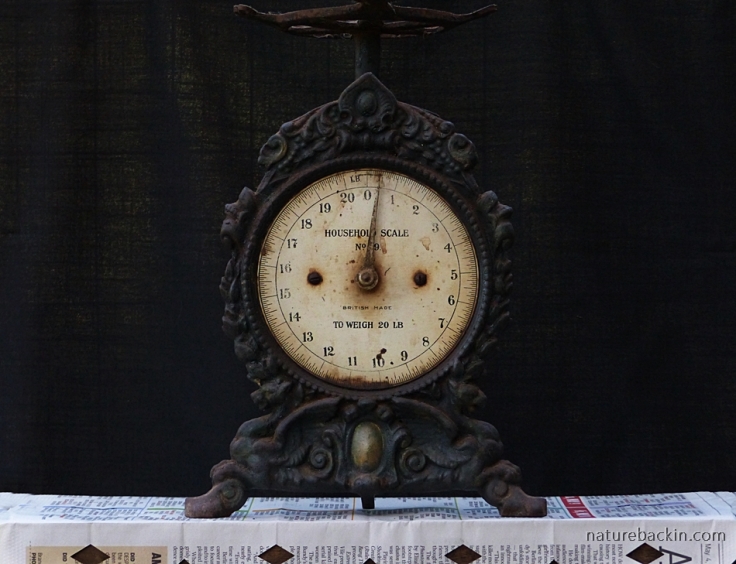
An incredibly heavy cast iron household scale that was inherited from my South African grandmother
Our relationship with technology and the commercialisation of just about everything is reflected in the development of the modern kitchen and in the food we eat. Although there are many places in the world where households rely on a central open hearth or an outdoor fireplace as a principal living and cooking space, the development of the kitchen as a space dedicated to efficiency, hygiene and convenience reflects a less connected relationship with what we eat and how we store and prepare our food.
The advent over time (and relatively recently) of chimneys, closed stoves, the use of coal, gas and electricity and the introduction of piped water have all played a role in altering the domestic spaces where we store and cook what we eat. (Wikipedia provides an interesting overview of the history and development of kitchens.)
That all our food originates from nature – in the form of plants and (for many people) animals – is so obvious that it is often overlooked. In an era of fast food, takeouts and instant meals, the previously ordinary skills enabling ordinary people to take unprocessed natural ingredients and turn them into food can seem like a curiosity or can be viewed with nostalgia, or else such abilities are revitalised into cult-like hobbies or transformed into high art by celebrity chefs in an era where we even have reality-TV cooking contests.
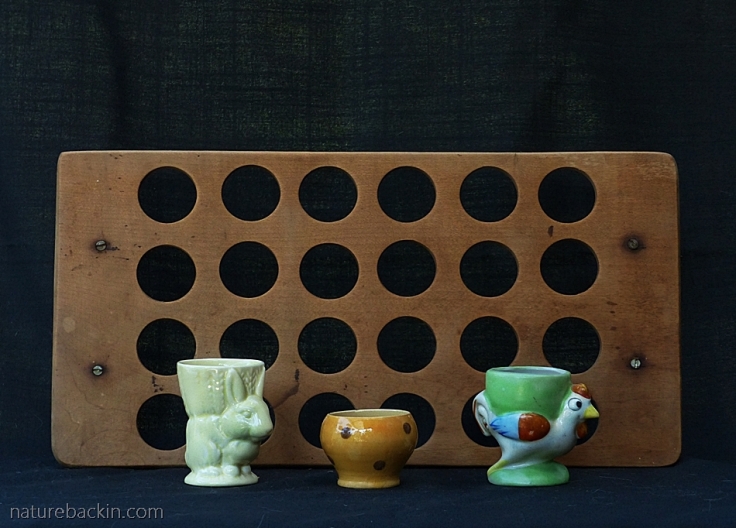
Tipped on its side to provide a backdrop to three old egg cups from my childhood, is my South African grandmother’s Yellowwood rack for storing eggs. Eggs were stored in the pantry, predating the appearance of the electric refrigerator as an everyday kitchen appliance. Before fridges, cooling of selected foods might be done in an ice chest. My father recalled blocks of ice cut to size being delivered on a regular basis in the Pretoria neighbourhood where he grew up between the two World Wars
Not only is food essential for life and for sustaining ourselves and nurturing our families, but it is also a social and cultural signifier. The kitchen items that I inherited remind me of a time when preparing (and often growing) food for storage and subsequent cooking were everyday procedures entailing a high level of skills that were regarded as unremarkable. These kitchen items provide tangible links to ordinary household practices from a generation or two ago.

We make use of several old traditional glass storage jars in our grocery store cupboard. Not easy to find, the newer ones tend to have inferior rubber gaskets and wire clamps in comparison to the sturdy old ones. For some of these photos, I covered a shelf in newspaper with simple cut-outs as was popular in kitchen pantries when I was a child

A bean slicer that belonged to my English grandmother. My grandparents had a most productive vegetable garden that together with their Bramley apple trees kept the family pretty well fed during the years of World War II. My grandfather continued to maintain a small vegetable garden that he kept going well into his 80s. The runner beans that he grew, my gran sliced, salted and bottled so that they had a steady supply of green beans throughout the winter. She never even thought of buying frozen veg even when it became readily available. Also in the photo is part of a scale that belonged to her parents. I can’t remember seeing her use it
Mentioning Bramley apples reminds me of the amazing traditional apple pies my gran used to make every week, apparently as easily as if making an instant packet dessert, using home-grown apples and homemade flaky pastry made from scratch. My gran never measured ingredients, not even for cakes, so I struggled to learn from her how to bake on the basis of “a handful of this and then add just enough of that”. When I knew her she used bought butter, but when she was growing up, her family made butter from farm milk.
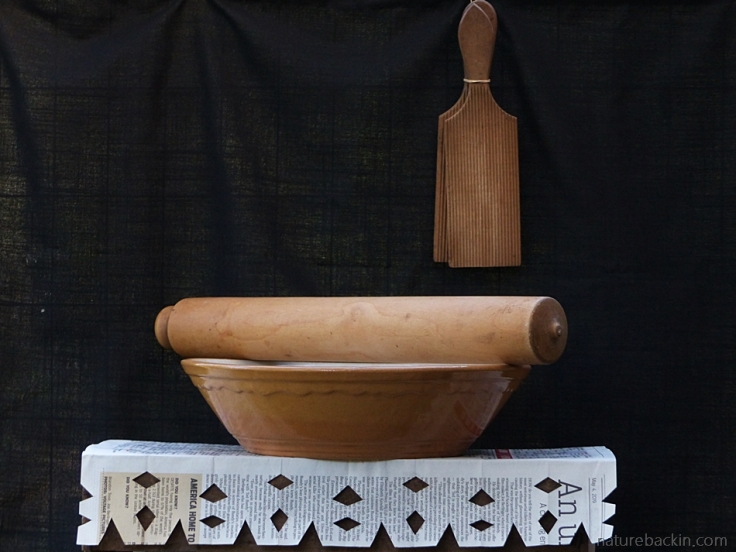
Butter pats, a rolling pin and a traditional bowl that belonged to my English grandmother. On the rare occasion when I need one, I still use this rolling pin
In the decades of the mid-20th century, in many urban areas including in the privileged parts of South Africa, milk was delivered in glass bottles to the door. Harking back to when milk was distributed from milk churns or perhaps so that empty bottles could be returned to the dairy for re-use, kitchen milk jugs were used to store milk and fancier jugs to serve milk at the table.

This milk jug was used by my South African grandmother to store milk in the refrigerator. It used to have a white ceramic disc as a lid. I was never sure if the lid was improvised or was made specifically to cover the jug
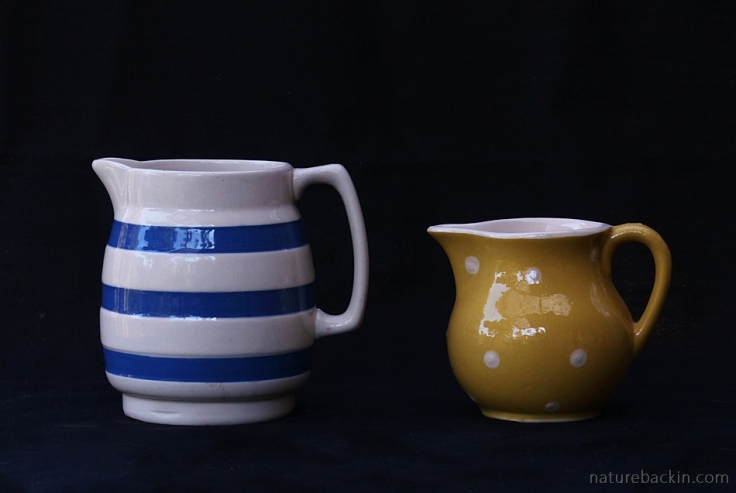
Two of my favourite jugs, suitable for use at the breakfast table, which my mother passed on to me
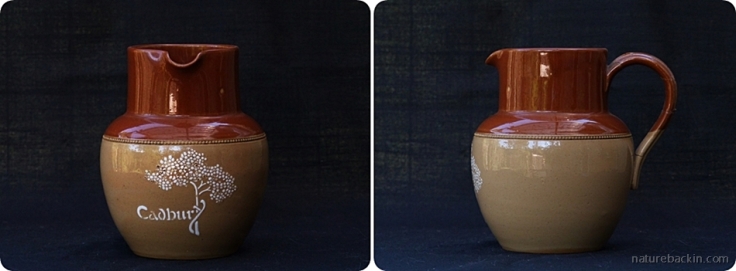
A Cadbury stoneware jug perhaps intended to promote drinking hot cocoa. My English grandparents would routinely have cocoa or milky instant coffee just before bedtime, but I don’t remember them ever using this jug
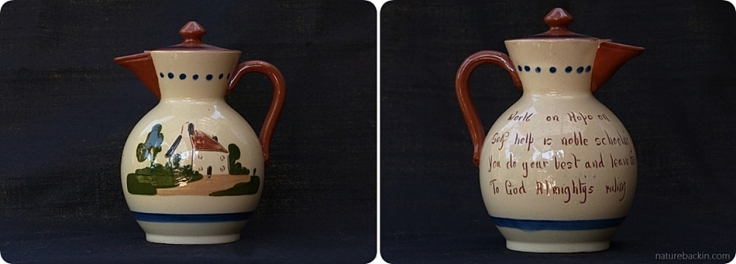
This pot suitable for tea or coffee was made at Watcombe Pottery, Torquay, England. It was likely bought by my grandparents on one of their regular holidays to Devon and Cornwell and also likely that it was purely decorative rather than used. The little homily on one side of the pot reads:
Walk on Hope on
Self help is noble schooling
You do your best and leave the rest
To God Almighty’s calling
While taking these photos, I was assisted by two of our cats who were interested by the new set up and investigated many of the pieces photographed here. Fortunately no breakages resulted from their inspections.

This is Nougat. Historically of course, cats were kept around homesteads to catch rodents that were after foodstuffs stored in barns and kitchens
Although many domestic skills were passed down from elders and practiced from a young age when children participated more in household tasks, with urbanisation, the advent of the nuclear family and the emergence of dedicated kitchen spaces, food and its preparation became increasingly commercialized and best practices were overtly endorsed in line with conventions related to gender roles, social class and even moral virtue. I have inherited books that reflect such a convergence where advice given was not simply practical but was highly normative.

Two of my inherited books that include much advice related to food are pictured here. Enquire Within Upon Everything is a veritable hardcopy “Google” equivalent. The book provides no publication date, but I guess this edition is likely to be from the early 1930s. Some of its advice is so surprising I might share some such gems in a future post

These advertisements for cookery books appear adjacent to the back flyleaf at the end of Enquire Within Upon Everything. I think they reflect quite well something of the flavour of the times. The first is “for the housewife who has to carry out her domestic duties in a house with but one maid” and the second carries recipes with two versions to “suit two different kinds of purses” as the author “aims at helping the servantless by teaching economy in time and materials”
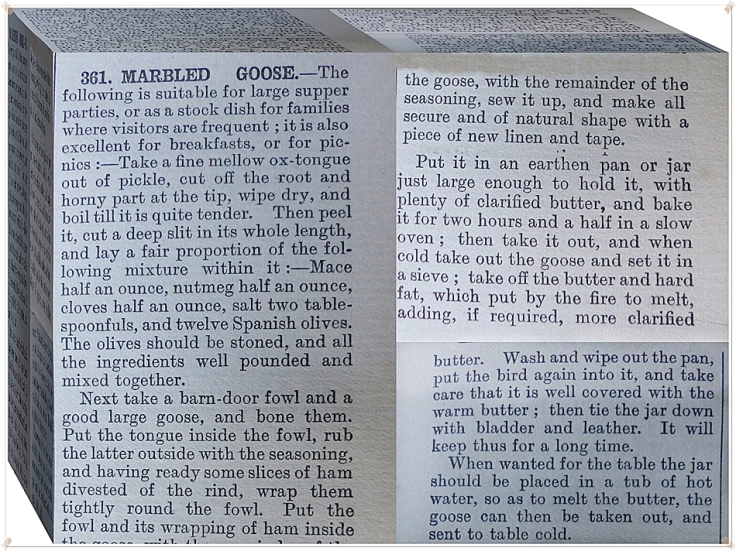
Also from Enquire Within Upon Everything, I was incredulous the first time I read this recipe (inexpertly cut and pasted above). Essentially, to make Marbled Goose one takes a pickled ox tongue, proceed to boil it then slit it and fill it with spices and 12 Spanish olives pounded together. The stuffed tongue then gets stuffed into “a barn-door fowl” (deboned), which is then wrapped in slices of ham and in turn stuffed inside a goose (also deboned), and it is all sewn up and taped in a “natural shape” before being baked for 2 ½ hours in clarified butter in an earthen pan or jar. After a bit more work, the goose and its contents can be re-immersed in melted butter and stored in the jar, which is tied down “with bladder and leather” and can be kept “for a long time”

This large stoneware bean pot was given to me by my mother. She had inherited it from her mother and as far as I know it came in turn from her mother’s mother. I don’t remember seeing it being used but it was a treasured family item. Bean pots were used for slow baking beans, such as haricot beans, but I imagine it could also have been used for baking marbled goose such as in the recipe above
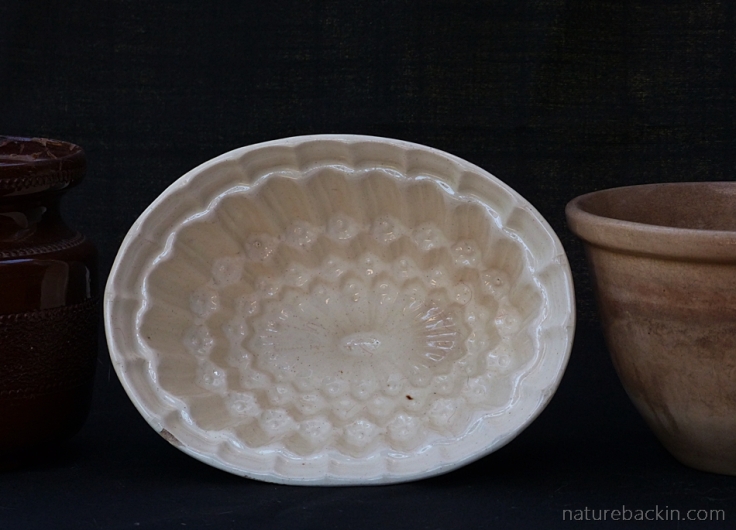
I have tried using this old jelly mould for sweet jellies, but even when rinsing it in cold water prior to using, the jelly gets thoroughly stuck once it has set and I try to unmould it!

I really like the simplicity of a glass lemon squeezer. It would have been especially useful when squeezing a quantity of lemons such as when making lemonade. This one belonged to my South African grandmother. The old-fashioned rough-skinned lemon was grown in our garden
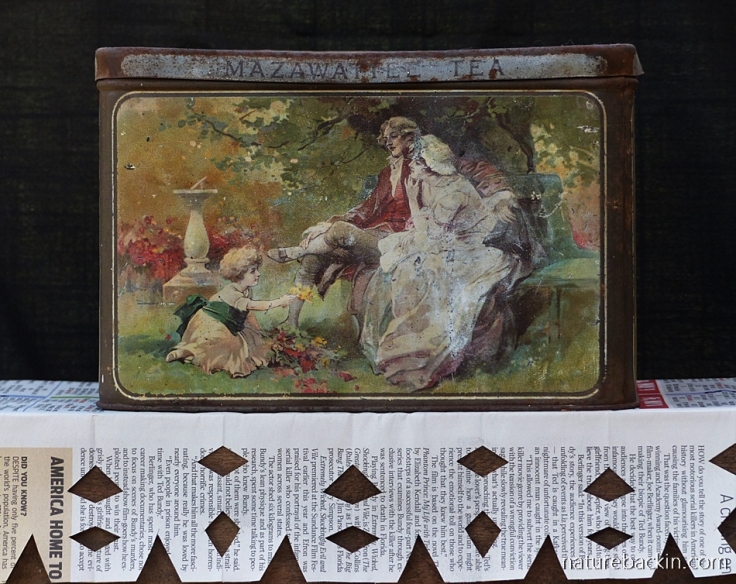
This old Mazawattee Tea tin was kept by my aunt to store old papers and bits and pieces. This decorative tin does not feature the famous image of a grandmother and child drinking tea that appeared on many of the tins and advertisements for this British tea company. Mazawattee tea ceased being produced during World War II, but the brand name was revived in 2017

I am not sure that this pot would have been regularly used to make tea or if rather it was a display item, although there are traces of tea stains inside. The potters mark underneath identifies it as made by John Maddock and the design is “Rustic”. I have never used it to make tea nor do I recall anyone else using it, and I generously describe it as being quaint rather than charming

And to end, this robust and beautiful basket was used by my mother-in-law as her vegetable shopping basket. We still use it occasionally when we need to take food items when visiting friends, but we no longer use it when we visit the local farmer’s market as after decades of use it has become quite frail

Sources:
Laudan, Rachel, review of The Birth of the English Kitchen, 1600-1850, [by Sara Pennell] (review no. 2180) Reviews in History. https://reviews.history.ac.uk/review/2180
Old favourite Mazawattee Tea enjoys rebirth. 2018. Beverage Business World. https://beveragebusinessworld.com/latest-news/old-favourite-mazawattee-tea-enjoys-rebirth-11-09-2018/
Wikipedia. 2018. Kitchen. https://en.wikipedia.org/wiki/Kitchen
Posted by Carol









September 18, 2019 at 1:36 am
Loved the post. I enjoy collecting old household things.
LikeLiked by 1 person
September 19, 2019 at 7:20 pm
Thanks Preethi – glad to hear that you also enjoy old household things.
LikeLike
September 12, 2019 at 7:36 pm
A collection of treasures indeed.
LikeLiked by 1 person
September 12, 2019 at 8:02 pm
Thanks Dorothy – glad that you also think they are treasures 🙂
LikeLike
July 2, 2019 at 2:23 am
Ah, what a wonderful glimpse into the past, Carol! I remember lots of these in use at my grandparents’ homes, especially on my moms side who lived on the farm. And being sentimental, I now wonder what happened to it all when they moved.
I did get a lot of old books – English and Afrikaans – from my grandfathers, and reading those today has me gasping at how utterly un-PC they are in today’s terms, though entirely appropriate in the times they were written.
LikeLiked by 1 person
July 4, 2019 at 7:36 pm
I know what you mean about such old books – they can be a real eye opener and hopefully not too cringe-worthy.
LikeLiked by 1 person
July 1, 2019 at 8:54 am
I love this blog Carol! So many of the items, though slightly different, I have also inherited and the old scale is the only one I use when I have to have specific weights instead of my usual, a handful plus two pinches! xxxx
LikeLiked by 1 person
July 4, 2019 at 5:31 am
Glad this post resonated and how nice to still be using the old scale when guestimating needs some help.
LikeLiked by 1 person
June 29, 2019 at 7:41 pm
Thank you yet again for a wonderful post. I sometimes wish I was born before this time. When life was more simple, hard but simple.
I love the photos and love the kitties🥰
Looking forward to your next insights ❤️
LikeLiked by 1 person
July 4, 2019 at 5:29 am
Thanks Debs. I think there maybe was a more “for real” quality when people were doing it for themselves more than many of us do today!
I am glad the cats took part when I was taking the photos 😊
LikeLike
June 29, 2019 at 4:06 pm
A very enjoyable post, thank you. We have recently been visiting Living Museums in England related to households in Victorian times which I can vaguely remember from my grandparents days. My wife is from nepal and still won’t let me throw anything away 😂😂
LikeLiked by 1 person
July 4, 2019 at 5:26 am
Thank you. I think it is invaluable that living museums keep old techniques alive. I think that not wanting to throw anything away is a good instinct in our all too readily disposable society where we often fail to value what we have and we pursue novelty for its own sake.
LikeLiked by 1 person
June 29, 2019 at 10:18 am
Thank you for this post! We have indeed drifted into a very, well, flippant relationship with food and indeed with material things in general. ‘Learned helplessness’ sums it up well.
Anyway, you’ve got a wonderful collection there. Something else that about old equipment that I often notice: while functional, it remains artistic. The iron work on scale, for example. It is like its crafter is treating it with respect, very unlike mundane mass production on a factory line.
Looking forward to hearing more from those old books!
LikeLiked by 1 person
July 4, 2019 at 5:20 am
Thanks Adele. The disposable quality of so much, including junk food, is so unsatisfying and wasteful. We need somehow to take back respect, which has been lost in highly materialistic societies. You use the word flippant, which describes it well.
LikeLiked by 1 person
June 29, 2019 at 6:32 am
Oh dear, this has made me feel old! Growing up on a dairy farm I remember having a pantry, and making cream and butter on occasion. The jugs and jelly mould look very familiar. We tended to eat a good deal of food from the garden and homemade pies. Ironically, as a kid, a favorite treat was going to town and having what we called ‘an artificial cream bun.’ Luckily, that line of interest didn’t win out and I have always been grateful that I learned to cook and bake on the farm, skills and interests that serve me to this day.
LikeLiked by 1 person
July 4, 2019 at 5:05 am
Glad the artificial cream buns proved to be only a passing fancy! I remember my gran loving some new and ugly cutlery with plastic handles as being so much easier to clean than her beautiful old bone-handled pieces – an opinion she stuck to.
LikeLiked by 1 person
June 28, 2019 at 3:00 pm
What a beautiful post, Carol. So true that we have wandered far from a real connection with our food and indeed with our kitchens. I have nothing like the lovely pieces you have shared with us but your post took me straight back to my grandmother’s kitchen and I find I can remember it quite clearly: the layout, the furniture, the homemade lemonade… Thank you for sharing 🙂
LikeLiked by 1 person
June 28, 2019 at 3:23 pm
Its nice to find space for reflective nostalgia at least once in a while 🙂
LikeLiked by 1 person
June 28, 2019 at 11:30 am
Very Interesting. Our time has come to get rid of all the objects that we do not use any more, but reading your post, think I should hang onto some of them for a while longer!! Excellent photos once more, Carol!
LikeLiked by 1 person
June 28, 2019 at 3:22 pm
I am a great believer in the richness that old and loved things can bring to our lives and living spaces. I do acknowledge though that it can be cathartic to pare things down and that less can be more. I hope that you find a comfortable balance. Perhaps one day I will 🙂
LikeLike
June 28, 2019 at 1:34 am
Interesting post, Carol. A shame that so many kitchen/household items are no longer recognizable to us. There is a New England monthly magazine that features photos of old house and farm tools with explanations of how they were used. As well, there are dedicated groups of people that restore and use tools like spinning wheels, looms, etc. keeping these old skills alive, often seen demonstrating at fairs, etc. I really admire that.
LikeLiked by 1 person
June 28, 2019 at 3:13 pm
Yes I also admire and appreciate keeping those old skills alive. Our neighbour belongs to a woodworker guild and they have a wonderful old workshop near a working blacksmiths forge at a country house and farm that hosts such a fair every year. The woodworkers make beautiful wooden toys with miniature details perfectly executed each year for display before donating the toys to children’s homes. Such a lovely practice.
LikeLiked by 1 person
June 28, 2019 at 9:36 pm
That is wonderful!
LikeLiked by 1 person
June 27, 2019 at 9:58 pm
Fabulous post, Carol. It was like reading about my own grandparents and the way they conducted themselves.
LikeLiked by 1 person
June 28, 2019 at 3:08 pm
Thanks Ark. That generation learnt to be very resourceful. I have a lot of respect for that.
LikeLiked by 1 person
June 27, 2019 at 9:12 pm
Love the tea tin! When I visited NZ in 2015 I stopped in a little town named Owaka. Here you can find Teapotland: a typical NZ detached house with a small garden, filled with over 1000 teapots in all imaginable forms!! It was really funny to see these creations.
LikeLiked by 1 person
June 28, 2019 at 3:06 pm
Teapotland sounds incredible – must include quite a kitsch fest I should think?! I used to have the kitschiest old teapot decorated with bright orange and yellow nasturtiums. To my husband’s relief, I parted with it 🙂
LikeLiked by 1 person
June 29, 2019 at 7:37 am
Keep the peace in marriage 😁
Yes, unbelievable kitsch there…
LikeLiked by 1 person
June 27, 2019 at 9:04 pm
This is a wonderful post. Sadly, although I was lucky enough to be brought up with many traditional kitchen skills, not all of which I use (bottling fruit and veg), I only have a few Mason jars and Kilner jars from the ‘good old days’. Until recently, I had a jelly mould like yours. It was useable. But who eats jelly now? I loved trawling through your treasures. Thank you!
LikeLiked by 1 person
June 28, 2019 at 3:03 pm
Glad you enjoyed the old treasures – they do bring back memories and associations. Refrigerators have changed things a lot. Good question about jelly! It is still recommended for those with post-surgery nausea as a way of keeping hydrated, but that is not an appealing incentive is it!!
LikeLiked by 1 person
June 27, 2019 at 8:53 pm
True treasures! Love it. ❤️
LikeLiked by 1 person
June 28, 2019 at 2:59 pm
Yes they are. Glad you also like them. I would have a hard time being a minimalist 🙂
LikeLiked by 1 person
June 27, 2019 at 7:37 pm
You are very fortunate to have so many beautiful and functional keepsakes from the past, Carol.
LikeLiked by 1 person
June 28, 2019 at 2:58 pm
Yes it is lovely to have these old keepsakes. I like that they are not purely ornamental.
LikeLiked by 1 person
June 27, 2019 at 7:08 pm
A pleasant trip down memory lane and I enjoy the newspaper shelf linings – very appropriate. We used to have that in our farm house. I still use my glass lemon squeezer and store tea in the traditional Mazawattee tea tins passed down to me. My basket like yours has finally given in to age and one too many heavy loads it had to carry … an ancient household encyclopedia I have even advises me to brick up windows to save on having to pay ‘light tax’!
LikeLiked by 1 person
June 28, 2019 at 2:57 pm
Nice to know that you also remember the newspaper shelf linings and that you still use and cherish the lemon squeezer and tea tin 🙂 Sorry the basket is finally giving in. Your household encyclopedia must be quite an age to advise on avoiding window tax!
LikeLike